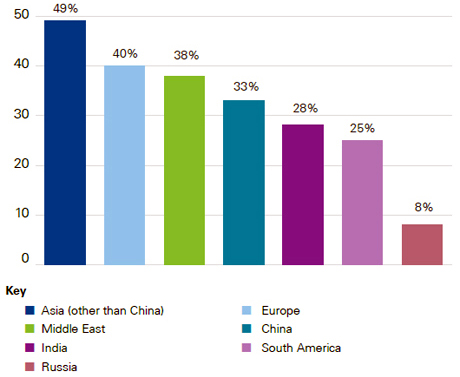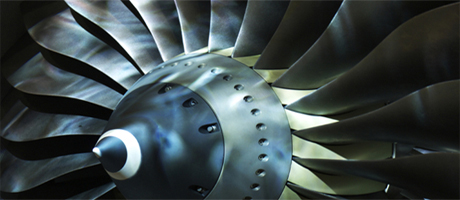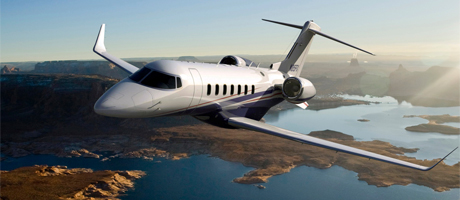Aerospace & Defense
Commercial
The global commercial and regional aircraft market is expected to continue to witness significant growth, led by increases in demand from emerging economies, higher air traffic rates, and increasing market liberalization worldwide.
With increasing demand from countries experiencing continued wealth creation -primarily from India, China, the Middle East and other Asia-Pacific region countries- the sector is forecast to reach approximately $123 billion in 2020. Global commercial and regional aircraft companies design, assemble, market, and sell large commercial and regional aircraft, usually narrow body and wide body aircraft for transporting passengers and cargo.
JS&A supports the global commercial and regional aircraft market -with a team of senior principals- by providing valuable information, insights, and tools needed to identify new growth opportunities and capture new business . We work with designers, manufacturers and service suppliers of aircraft interior, landing gear systems, engine MRO, avionics, and fuel cell APUs.
More about the Aerospace & Defense | Commercial
Market Recognition
On December 17, 1903, Orville Wright piloted the first powered airplane 20 feet above a sandy beach in North Carolina. That flight lasted all of 12 seconds and covered 120 feet. More than 100 years later, aircraft manufacturers today are fabricating aircraft that can carry hundreds of passengers thousands of miles to destinations throughout the globe.
The aerospace market has been experiencing significant growth over the past decade. The critical success factor for continued growth is the increasing demand in developing countries. We believe the most successful companies will be those that can develop application-specific, customer-focused solutions and have the ability to help their customers achieve long-term business objectives, such as increasing efficiency and lowering costs with expanded lifetime of the aircraft.
Market Opportunities
Although North America has the largest share of the industry’s revenue, followed by Europe; growing demand from emerging economies such as China, India, and Middle East countries, as well as strong demand for low-cost carriers, especially in Asia, and high replacement rate for regional aircrafts- will be the driving growth engine for manufacturrers and service suppliers.
Aircraft Delivery Forecast (2013 - 2032)
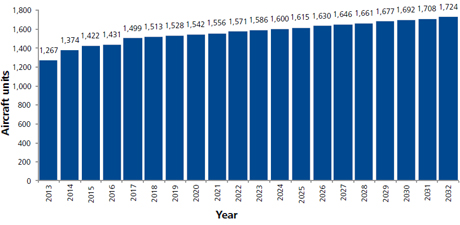
Source: DTTL Global Manufacturing Industry group analysis of data from Boeing
Seeking Competitive Advantage
Understand Your Customers and Influence Their Behavior
In a recent industry association survey, A&D executives believe that when it comes to gaining competitive advantage, their customers look for innovation in new products and services – which topped the list of factors at 44 percent. Price competitiveness and customer relationships tied in second place at 40 percent each - were also noted as key components toward achieving a competitive advantage.
JS&A works on behalf of our aerospace and defense clients in markets in Europe, Asia, the Middle East, Latin America and Africa. Through the experience and strength of our in-country -native team members- we are able to offer our clients quality advice and ideas, connect industry -functional and political- resources to solve problems, improve sales, increase the value of customer relationships and enhance the economic value of their brands.

Aerospace & Defense
Government
Defense Spending is Increasing in Several Areas of the Globe, Especially in the Middle East, India, China, Russia, South Korea, Brazil and Japan
With regional tensions continuing to simmer in the Middle East, North Korea, Ukraine, the East and South China Seas, it is expected that affected governments will continue to increase purchases of next generation military equipment. Many of these affected countries have produced the incremental wealth necessary to equip their militaries with modern defense platforms and technologies.
More about Aerospace & Defense | Government
In previous downturns, U.S. defense companies have merged with competitors, entered adjacent markets, entered entirely different markets, and concentrated on research and development to create next generation technologies. Selling more defense and military technologies to existing government customers will be difficult in a declining budget environment, thus competition for fewer programs is likely to be intensified during this period of contraction.
Revenues & Earnings for the Top 20 US Defense Firms
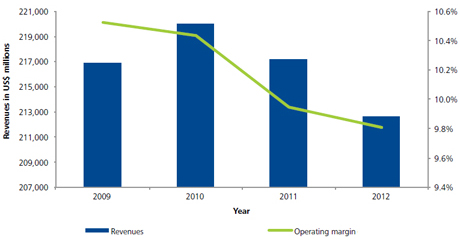
Return to Growth
A return to growth in a declining government spending environment will likely require the same kind of response as in previous downturns, plus more. It might include more emphasis on developing new products and technologies that support military mission requirements to address the new threat environment.
Governments are expected to continue to spend on programs of significant value, such as the next generation intelligence, surveillance, and reconnaissance technologies. The ability to know, process, and react in real time to events on the ground, in the air, and at sea will continue to be a strategic competitive advantage in armed conflict. The ability to process mega-billions of data bits provided by high resolution optics, communication sensing, and other multispectral sensors, is key to differentiating friend from foe, or tactical threat versus benign events. The use of advanced data analytics to sift through the data and make sense of it will be another strategic advantage in armed conflict. Innovations in these areas represent a source of potential growth for defense companies.
Another strategic area of growth that may help fill the revenue gap is international sales (whether FMS or DCS) to countries that are spending more on defense.
Opportunities and Challenges
Where next for your business?
Budgets are shrinking in the U.S., Europe and the rest of the Western hemisphere. But the situation is very different in Asia. China aims at becoming fully self-sufficient in terms of defence and has an impressive roadmap to do so. India has emerged as the world’s largest importer of major conventional weapons worldwide -12% of the global total. And the Middle East continues to be a reliable market for U.S. technologies.
However, it can be difficult to do business in certain foreign countries with the long decision cycles, investment requirements, and inadequate indigenous capabilities to perform offset work by foreign nationals.
For Defence Companies, Understanding New and Promising International Markets & Related Government Requirements Are Vital
Traditionally, defense companies have relied on their immediate customers for requirements: RFPs, customer leadership, customer engineers. They expressed greatest comfort and success when customers provided well documented sets of requirements at the start of each program. This approach has worked well and has had success over the years.
However, we believe that defense companies should proactively collect inputs from stakeholders throughout the value chain, not just the immediate customer - whereas, greater attention must be paid to the views and involvement of end users. This approach will potentially allow companies to find new opportunities and gain a competitive advantage over their competitors.
Aerospace & Defense
Business
Business aviation is essential to tens of thousands of companies of all types and sizes that are trying to compete in a marketplace that demands speed, flexibility, efficiency and productivity
Business aviation plays a vital role for citizens, companies and communities across the U.S. The industry is vital to the national economic interest, generating over a million jobs, helping thousands of businesses of all sizes to be more productive and efficient, and providing emergency and humanitarian services to people in need.
The industry went through a strenuous period as the demand for business jets is largely motivated by company profits. The market witnessed a severe downfall in the global economy in the year 2009, nevertheless, there are bright spots on the horizon for the business aviation manufacturing community. The industry is anticipated to witness growth led by increasing demand from emerging economies, economies recovering from global downturn, and increasing global corporate profits.
More about Aerospace & Defense | Business
The authors of Business Aviation Outlook, forecast up to 9,250 new business jet deliveries worth over $250 billion from 2013 to 2022
In that survey, the operators interviewed plan to make new jet purchases equivalent to about 28 percent of their fleets over the next five years either as a replacement or in addition to the their current fleet.
Higher purchase expectations continue to focus on larger cabin aircraft classes ranging from supermidsize through the ultralong range and business liner, implying these types of aircraft will command the bulk of the value billed from now until 2023. This large cabin group is expected to account for more than 80 percent of all expenditures on new business jets in the near term. Volume growth between now and 2023 will be led by this class of aircraft, reflecting nearly 60 percent of additional units, and nearly 85 percent of additional retail value.
Global Markets
- Fleets in the Asia Pacific region have been growing at double-digit rates throughout the past five years
- The level of purchase plans in the Middle East and Africa region is near the world average even though 2013 has been a year of significant political upheaval and ongoing conflict in the region
- Latin America's planned acquisitions remain more front-loaded than the world average, with almost 52 percent of this region’s projected purchases timed to happen within the next three-year period. As with the Asia Pacific market, backfilling appears to have eased, albeit to a lesser extent. As a result of the high purchase plan levels, Latin America’s share of total projected demand held steady at 18 percent
- North America, the industry’s mainstay market, has seen new jet purchase plan levels improve. Though these levels might be moderate when compared with emerging markets, North America represents more than half of projected global demand for the next five years based on the region’s historically dominant installed business jet base, affirming the region’s indisputable importance to the industry’s future
- Europe’s purchase expectations has declined. The resilience previously shown by European operators in the face of lackluster economic conditions may have reached the point of fatigue with weak growth prospects expected for 2015. Russia, which has supported the region with strong local purchasing ambitions, has significantly slipped in reported purchase plans
Driving Revenue Growth
Aerospace and defense companies must continually evaluate the way they operate to meet today's challenges, including globalization, financial constraints and unusually complex landscape. Many companies are betting on aggressive mergers and acquisitions strategies to help drive growth, which has been increasingly challenged by sluggish economic conditions, looming budget cuts, and increased competition.
Some organizations are also focused on international growth - continuing to list global markets among key growth strategies for the future. They also realize that in order to gain and maintain their competitive advantage with end customers, it is imperative -more than ever- to consistently provide high-quality products and services, strengthen customer relationships, and increase innovation.
JS&A helps clients chart new territory in such sectors as commercial aviation, military aerospace, ISR, military land systems, shipbuilding, and defense electronics in some of the most promising global markets. We have decades of experience working with your current and potential end customers, and fully understand the practice-driven processes required with each circumstance.
Strategic Guidance and Actionable Insights
How We Operate
The A&D industry continues to face a demanding market environment that requires companies to adjust and actively manage change that may affect sales and performance. Emerging markets are gaining in importance and competition and cost pressure are mounting in mature markets.
Our work is characterized by senior-led collaborative teams with substantial consulting and industry experience. Our work addresses the major issues influencing the thinking of decision makers and the decision process in which the end customer operate and the policy objectives they want to achieve.
JS&A has the industry depth, knowledge, and insight to help clients address their most pressing issues and achieve their goals. Our team includes professionals with the knowledge, experience, and skills to help our clients address their challenges, sort through today’s complex business problems, and achieve their goals.
Top A&D Markets for International Growth
International Growth Potential
